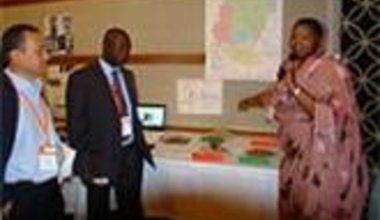Most Sudanese hazards cleared by mid-2011, UNMAS says
The UN Mine Action Office (UNMAO) had cleared its major routes of landmines or explosive remnants of war (ERW) and was working to rid the country of residual hazards by the middle of next year, a top UN mine action official said at an UNMIS-organized press conference on 28 January.
Concluding his visit to Sudan's most dangerous areas, including Kassala, Blue Nile, and Central Equatoria states as well as Darfur, UN Mine Action Service (UNMAS) Director Max Kerley added that UNMAO worked in close cooperation with the National Mine Action Authority and the Southern Sudanese Demining Commission. It also provided capacity building for the Joint Integrated Demining Units (JIDU).
"The JIDUs will be accredited soon so that they can conduct demining operations to an international standard," Mr. Kerley noted, adding that "UNMAS is working with the national authorities to hand over all mine action responsibilities by June 2011".
By the same deadline, 849 dangerous areas would have been cleared, the director said, in addition to the 587 dangerous areas that had been opened up since October 2009, of 1,436 recorded ones.
According to Mr. Kerley, 13,000 kilometres of road had been opened in Blue Nile State with the assistance of implementing partners, thus "facilitating socio-economic development in formerly contaminated areas along with the movement of internally displaced persons and refugees".
In response to journalist's questions, Mr. Kerley said no evidence existed of newly laid mines in the country, although ongoing conflict could result in contamination or re-contamination by ERWs.
"I do not think that there are any areas where the ability to vote is being seriously hampered by the presence of mines," the director replied to a question about risks jeopardizing the national elections scheduled for April.
"I am confident that we have done our utmost to make certain the electoral process will be safe as possibly can be from the Explosive Remnants of War and mine threats," UNMAO Director Nigel Forrestal added.
In Darfur, which was still affected by ongoing conflict, the greatest risk resulted from scattered ERWs instead of landmines, which in turn were to be found in a relatively small part of the western region, Mr. Kerley said
"If that residual threat were for some reason to increase significantly ... and if the government requested us to do so, we could assist them in dealing with that threat (beyond June 2011)," the UNMAS director added.
UNMAS began its Sudanese activities in 2002 in Southern Kordofan State. Since then, it has opened a total of 17,000 kilometres of roads in Sudan, cleared 29 square kilometres of land and provided mine risk education to one million people.
 UN
UN United Nations Peacekeeping
United Nations Peacekeeping




